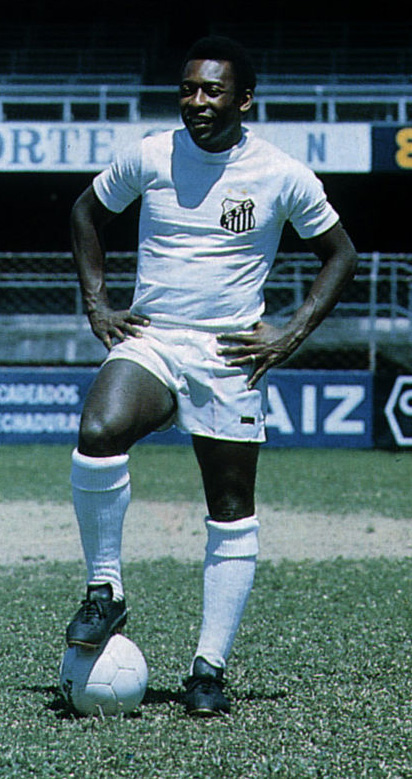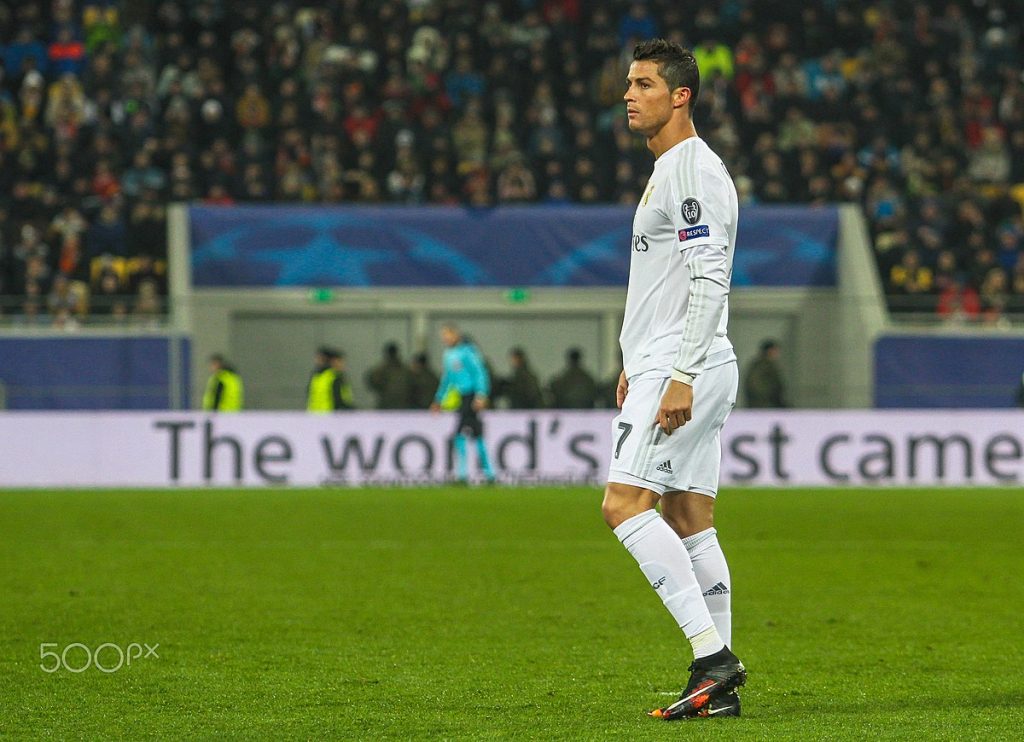Which professional sport offers the most lucrative contracts to top contenders?
If the first names that come to mind are Super Bowl-winning quarterbacks, baseball players with unbeatable batting accuracy, or top-scoring basketball stars, you’re in for a surprise. In fact, we’re talking about soccer, the sport that is known in most of the world as association football (not to be confused with American football).
Professional soccer in the United States is far less lucrative than the major leagues of other professional sports, but internationally, the opposite is true.
[Jump to our focus on salary inflation in professional football.]
The highest-paid pro soccer player in the world for 2021 was also the highest-paid athlete in the world, with a $75,000,000 salary that towered over the earnings of top players in other sports, Forbes reported. Today, the best-paid soccer player in the United States earns more than 100 times what the typical family in America makes, and the best-paid player in the world earns more than 1,000 times the median family income in the U.S.
It wasn’t always this way. In the same cities and countries where star soccer players now command exceptional salaries, earnings used to be much less lucrative. Some leagues capped earning potential by imposing maximum salary limits that rendered pro players, at times, with less earning potential than ordinary workers.
How did pro soccer players go from making an average of $20 per week to $70,000 per week? How did the very best players start to command salaries in the high tens of millions of dollars range? This progression took place over the course of 120 years, but the biggest jumps in salary increases occurred first in the 1960s, after salary caps were lifted, and then in the 1990s and through the first decade of the twenty-first century.
Notes About Historical Salary Data
Unearthing decades-old salary data can be a challenge, especially considering all of the different soccer leagues, clubs, and teams that have existed throughout the years. Generally, the data included in this article pertains to players on men’s soccer teams and draws from salaries reported across different leagues.
The data presented in this article was drawn from several sources, including spotrac, sportingintelligence.com (and the Global Sports Salaries Survey reports the news website has published every year since 2010), Spartacus Educational Publishers Ltd., Soccer Blade, the Daily Mail, Forbes, and more. Early salaries, in particular, are samplings of the salary data available during that time frame, since comprehensive salary data is not always available. Where possible, actual top-earning players’ salaries are provided, although data pertaining to maximum salaries and average salaries of top-tier players may also be used.
Because professional soccer (and association football) encompasses teams and leagues playing across dozens of countries all over the world, the available salary data is published in different currency values. The data in this article is expressed in United States currency not adjusted for inflation unless noted otherwise. To express data in this way consistently, we used a Historical Currency Converter and, where needed, data from Exchange Rates UK.
[Get a deeper look at salary inflation across all professional sports.]
Where in the World Are Soccer Players Earning the Most Money?
Soccer is a global sport, but that doesn’t mean the top-performing players all over the world are earning equal salaries.
Generally, star soccer players in Europe report the highest earnings. The player with the top per-season pro soccer salary in 2021, playing for Paris Saint-Germain (PSG) in France, out-earned the U.S.’s highest-paid player of American football that same year by more than 60%.
In China, too, earning potential for top-performing soccer players is extraordinarily high. In terms of how the average salary for professional players compares to the national average salary, China’s soccer players are rated the highest. The $1,051,603 average salary for top-tier soccer players in China’s Super League amounted to more than 160 times the national average salary of $6,567.93, according to the online platform vouchercloud. The top-paid association footballers in China earned in less than two days and six hours as much as the average worker earned in an entire year.
Even the best pro soccer players in the United States, Mexico, Brazil, and other countries make considerably less than their peers across the pond. The highest-paid pro soccer player in the United States earned less than 10% of what the highest-paid player in Europe reported in 2021. Still, the vouchercloud report put soccer salaries in the United States pretty much in the middle of the pack as it pertains to the percentage professional athletes earn above the national average salary. The top-earning Major League Soccer players in the U.S. reported an average salary of $352,992 for 2018, which amounted to more than 6.8 times the national average salary of $51,484.94.
[Jump to our focus on salary inflation in professional baseball.]
Maximum Salaries in the First Half of the Twentieth Century
Professional—that is, paid—soccer’s origins date back to the mid-1880s. Paying players at that time was considered grounds for disqualification from England’s Football Association Cup, but the following year, the Football Association announced plans to legalize paying players “only under certain restrictions.”
Throughout much of the first half of the Twentieth Century, those restrictions included maximum wage caps that limited salary potential for footballers playing in England under the Football Association.
For the 1901 through 1902 soccer season, players in the Football League weren’t allowed to earn more than £4 per week, or less than $20 per week in U.S. currency at the time. In comparison, the average American was earning around $12.98 per week at that time, according to BizFluent.
That £4 per week salary was quite good at the time, about doubling what skilled trade workers could expect to make. However, the very best soccer players in the United Kingdom at the time had been already earning more than twice the weekly salary at which earnings were now capped. The new rule establishing a £4 per week maximum salary led players to leave the Football Association in favor of playing instead for leagues without salary caps in place—some of which were reported to have offered signing bonuses of up to £100.
Maximum salary amounts fluctuated over the decades that followed, first to £10 ($36.60 in U.S. currency) after World War I, then down as low as £8 ($30 in U.S. currency) during the season and £6 ($22 in U.S. currency) throughout the offseason around 1924.
In the late 1940s, the maximum salary for soccer players in the Football Association had risen to £12 (around $48 in U.S. currency) per week during the season and £10 (around $40 in U.S. currency) per week through the offseason. All professional players for the Football Association who were over the age of 20 were required to be paid a minimum wage of £7 ($28 in U.S. currency) per week.
The salary cap rose steadily throughout the 1950s. In 1951, players for the Football Association couldn’t make more than £14 (around $39 in U.S. currency) per week. By 1957, that salary cap had climbed to £17 (more than $47 in U.S. currency) per week. The following year, the salary cap would hit a new and final high: £20 (approximately $56 in U.S. currency) per week.
Throughout these decades, the maximum salary allowed for players of the United Kingdom playing under the Football Association became less and less lucrative. Whereas players earning the maximum salary in 1939 made twice what the average industrial worker made, by 1960, the best-earning players were only earning about 30% more than the average earner, according to Spartacus Educational Publishers Ltd.
The continued existence of the Football Association’s maximum salary cap became more and more contentious, likely due in large part to this failure of the salary cap to keep pace with wage increases outside of professional soccer and to threatened labor strikes. Finally, in 1961, the league-wide maximum salary was abolished, setting the stage for dramatic salary growth among professional soccer players.
Pro Soccer Salaries Increase 50-Fold Throughout the 1960s
With the maximum salary abolished, top soccer players were immediately able to earn exponentially more money. In less than a decade, the top soccer players’ weekly salaries increased 50-fold from £20 to £1000.

IMAGE SOURCE: Hesekiel, Wikimedia Commons, Creative Commons Attribution-Share Alike 4.0 International license
During the 1961 season, Johnny Haynes, captain of the England national team, became the first player to earn £100 ($280.48 in U.S. currency) per week, according to the English Football League. To compare, the median family income reported for U.S. workers in 1961 was $5,700 per year or $109 per week, according to the U.S. Census Bureau.
No name in international soccer dominated the early 1960s like Pelé, a player for the Brazil national football team whose full name was Edson Arantes do Nascimento. Pelé was widely considered the best soccer player in the world, leading his team to multiple championship victories—including World Cup wins—in the late 1950s and early to mid-1960s, according to sports website Yardbarker, and he would later be named the FIFA Player of the Century.
It’s no surprise, then, that Pelé was reported to be the best-paid professional athlete in the world in 1963, according to A Brief History of Brazil by Teresa A. Meade. His earnings as a pro soccer player that year were reported to be above $200,000 in U.S. currency. Considering that the median income for all families in the United States in 1963 was about $6,200, according to the U.S. Census Bureau, Pelé could be said to be earning 101 times what the average family made.

IMAGE SOURCE: Unknown author, Wikimedia Commons, public domain
Not all of Pelé’s considerable earnings consisted of his salary—which at the time was reported to have been “comparably modest,” according to Pelé: A Biography by Lew Freedman—and the bonuses awarded for his unparalleled performance on the field. TIME reported Pelé’s April 1963 salary and bonuses as $40,000. Even going by this much more modest figure, Pelé was making more than 6 times what the average American family earned in a year.
Just because Haynes was earning massive per-week wages compared to the maximum weekly salary that had so recently been abolished doesn’t mean that every top-performing soccer player earned so much. Even among outstanding pro soccer players, huge wage gaps persisted. Pat Dunne, the goalkeeper for Manchester United, signed a two-year contract for the 1965 through 1967 soccer seasons that awarded him only £35 (around $97.65 in U.S. currency) per week. That’s actually less than the $142 weekly (based on a median annual income of $7,400, according to the U.S. Census Bureau) that the typical American family could expect to earn in a year.
In 1968, International Hall of Famer George Best earned £1,000 ($2,408 in U.S. currency) a week playing for Manchester United, according to Sportsman HQ. Meanwhile, the average American family was only making $7,700 per year, or $148 per week, according to the
U.S. Census Bureau. Best’s weekly earnings amounted to more than 16 times what “regular” families in America were making.
[Jump to our focus on salary inflation in professional hockey.]
A Record-Shattering Pro Soccer Contract Marks the Mid-1970s
Overall, professional association football salaries continued to grow during the ‘70s, topping £1,000 per week for high-performing players. However, one specific player—Pelé—achieved a massive three-year, multimillion-dollar contract in the mid-1970s that would stand out beyond all other salary growth that occurred throughout the decade.
In 1970, Pelé, then 29 years old, was reported by The New York Times to be earning $144,000 playing soccer, or around £1,150 per week. It’s worth noting, though, that the publication did not break down how salary, bonuses, or external endorsement deals were involved in those earnings. Pelé’s $144,000 earnings during the 1970 season amounted to more than 15 times the $9,870 median family income in the United States that year, according to the U.S. Census Bureau.
In 1975, Pelé broke new records to become the highest-paid athlete in the world, this time playing for the New York Cosmos in the United States. Of the $7,000,000, three-year contract Pelé was awarded, $2,000,000 was expected to go toward taxes, according to The New York Times. The $2,333,333 yearly average pay Pelé received through that contract amounted to 170 times the $13,720 median family income in America, as reported by the U.S. Census Bureau.
The highest-paid pro association football player in Britain in 1979, Peter Shilton, was earning £1,200 ($2,437.42 in U.S. currency) per week, The Sun reported. That figure amounted to more than 7.5 times the $317 per week (based on the $16,530 annual median family income reported by the U.S. Census Bureau) that the typical American family was earning.
More Soccer Players Entered the Upper Echelon of Earners During the 1980s
Despite the huge salary gains made in pro soccer salaries in the 1960s and 1970s, only limited data is available for the 1980s.

IMAGE SOURCE: Unknown author, Wikimedia Commons, public domain
Diego Armando Maradona was widely considered the best association football player in the world in the 1980s, according to Bleacher Report, Inc., and his career peaked during this decade—yet even for him, salary data for individual years isn’t publicly available. Celebrity Net Worth reported that Maradona earned a combined salary of $43,000,000 from 1984 through 1991. These earnings included a major 1990 contract with Società Sportiva Calcio Napoli under which, according to the International Business Times, Maradona would earn $3,000,000 (unadjusted) in salary and between $8,000,000 and $10,000,000 in endorsement deals.
The data that is publicly available is less specific. Among English professional association football players who qualified for the top division, the basic average salary during the 1984 through 1985 soccer season was £480 per week, or £25,000 per year. That amounts to around $557.31 per week, or $29,026.37 per year, in U.S. currency. Factoring bonuses, top-division players could earn up to £36,000 ($41,797.97 in U.S. currency) per year. That’s still a far cry from Pelé’s—or even Peter Shilton’s—top salaries of the ‘70s. To give these figures some perspective, the median family income in the United States in 1985 was $23,620, according to the U.S. Census Bureau.
What is known about pro soccer salaries in the ‘80s is that the number of high-paid players increased. According to sportingintelligence.com, just eight soccer players in England were earning £50,000 per year in salaries during the 1980 through 1981 season, but more than 40 players reported salaries this high by the 1984 through 1985 season, and the number kept climbing. £50,000 per year in 1985 translated to around $58,052.73 in U.S. currency—nearly 2.5 times the $23,620 median household income that the U.S. Census Bureau reported for 1985.
Why is specific salary data for top soccer players in the ‘80s so scarce? Sports salary data hasn’t historically been publicly available on a consistent basis. Sports historians may simply have less interest in the top salaries of this decade. Gains in professional soccer salaries in the ‘80s weren’t as record-breaking as they were in the ‘60s and ‘70s—and they were soon eclipsed by much more meaningful earnings increases in the 1990s.
English Association Footballers’ Top Weekly Salaries Climb From £10,000 to More Than £52,000 Throughout the 1990s
The‘90s saw the per-week earnings of the highest-earning soccer players in the United Kingdom increase by 500%. While the best-paid soccer players earned dozens of times what the average family did in the early ‘90s, they were earning more than 100 times typical working families by the decade’s end.
The early 1990s brought per-week salaries of £10,000 ($18,725.01 in U.S. currency) for star players of association football in England, including John Barnes and Chris Sutton. The per-week salaries of top earners would quintuple (multiply five times) by the end of the decade.

IMAGE SOURCE: Robbie Fitzpartick, Wikimedia Commons, Creative Commons Attribution-Share Alike 2.0 Generic license
Eric Cantona would be earning £18,000 ($26,594.95 in U.S. currency) per week by 1994, followed by Dennis Bergkamp’s £25,000 ($39,070.02 in U.S. currency) per week pay rate in 1995. While Alan Shearer played multiple seasons at a rate of £34,000 ($56,307.25 in U.S. currency) per week in the late ‘90s, Fabrizio Ravanelli reported the highest earnings for 1996 at £42,000 ($65,150.31 in U.S. currency) per week. At the close of the decade, Roy Keane topped the list of the highest-paid players with earnings of £52,000 ($86,002.65 in U.S. currency) per week.
How did the salaries of the best pro soccer players of the 1990s compare to average earners outside the international soccer scene? When Barnes and Sutton were earning around $18,725 per week in 1992, the median family income in America was $36,812 for the entire year, or $707 per week. That puts these pro soccer players’ weekly earnings at 26 times that of the average American family, according to the U.S. Census Bureau.
In 1994, Cantona’s $26,594-per-week earnings amounted to 42 times the $620-per-week earnings (based on an annual median family income of $32,264 reported by the U.S. Census Bureau) reported for typical families. Bergkamp’s 1995 earnings of $39,070 per week amounted to nearly 60 times the $655 per week (based on the median family income figure of $34,076 reported by the U.S. Census Bureau) that average American families could expect to make that year.
The $65,150.31 per week earnings that Ravanelli enjoyed in 1996 amounted to more than 95 times the $682 weekly income for the typical family (based on the $35,492 figure reported as the median family income by the U.S. Census Bureau). Keane’s 1999 weekly earnings of around $86,000 far outshone that of the average working family, for whom the U.S. Census Bureau reported a median family income of $42,000 for the entire year. The median weekly earnings of families amounted to $807, while Keane earned more than 106 times that amount.
Top Pro Soccer Salaries Climb to Hundreds of Times the Median Income Rates Throughout the 2000s
It didn’t take long for pro soccer salaries in the first decade of the new millennium to increase exponentially. Sol Campbell’s £100,000 per week ($149,094.70 in U.S. currency) salary in 2001 nearly doubled Keane’s record-breaking weekly earnings from just a couple of years prior. It also amounted to more than 183 times the $812 per week median income for typical American families (based on the $42,228 annual median family income reported by the U.S. Census Bureau).
The 2006 through 2007 season saw Andriy Shevchenko earn a salary of £118,000 ($203,129.43 in U.S. currency) per week. The following year, John Terry commanded a salary of £135,000 ($264,772.90 in U.S. currency) per week. Robinho (Robson de Souza) reported earning a salary of £160,000 ($321,178.16 in U.S. currency) per week during the 2008 through 2009 season.

IMAGE SOURCE: Alfonso Jimenez, Wikimedia Commons, Creative Commons Attribution-Share Alike 2.0 Generic license
While these top soccer players’ salaries climbed, earnings for ordinary people were stagnant. The National Center for Education Statistics reported median salaries of $52,400, $53,400, and $52,700, respectively, for the years 2006, 2007, and 2008. Shevchenko was earning 201 times the $1,007 median family income per week. Terry’s salary amounted to 258 times the $1,026 weekly median household income, and Robinho’s salary amounted to 317 times the $1,013 median weekly family earnings.
In 2009, Carlos Tevez made history with a salary of £286,000 ($417,875.28 in U.S. currency) per week, the Daily Mail reported. Meanwhile, the median household income in the United States was $50,221, or $965 per week, according to the U.S. Census Bureau. Tevez was earning more than 433 times what the average American family was making.
Tevez was the first player to earn a salary of more than £1,000,000 per month, but he wouldn’t be the last.
$1,000,000 Per Week Salaries Emerge in the 2010s
Just a few decades earlier, pro soccer players were lucky to be earning £100, or a few hundred dollars in U.S. currency, per week. During the 2010s, the best-paid players began to earn upwards of $1,000,000 per week. In fact, by 2011, the Daily Mail featured an article asserting that “too many average footballers are millionaires.”
By the mid-2010s, individual star players were earning more in one week than whole teams had earned for the entire season just half a decade earlier. In 2016, Wayne Rooney of the England national team reported earning £250,000 ($370,835.89 in U.S. dollars) per week, while the entire Manchester United team earned a collective total of £204,028 for the entire 1969 season. Instead of measuring pro soccer players’ wealth by their weekly salaries, sports experts and the media began reporting annual salary rates.
The highest-paid soccer player in the Premier League (EPL) of the English football league system, Chelsea Football Club’s Fernando Torres, earned £16,938,935 ($26,295,445.77 in U.S. currency) in 2011, according to Spotrac. Meanwhile, David Beckham was the highest-paid player in the United States’s Major League Soccer (MLS) league, reporting an annual salary of $6,500,000. Torres was making 525 times the $50,054 median household income (as reported by the U.S. Census Bureau) in the United States, and Beckham was earning 129 times what ordinary families earned.
Torres continued to lead the EPL in salary throughout the first half of the 2010s, repeating his 2011 salary throughout these seasons. In the MLS, it wasn’t until 2014 that a player for a U.S. team would surpass Beckham’s earnings. Orlando City Soccer Club’s Ricardo Kaká reported earning a salary of $7,167,500 that year.
Although Torres’s salary stayed the same, changes in conversion rates over the years mean that his 2014 earnings were equivalent to $28,020,253.40. He was earning 522 times the $53,657 median household income reported by the U.S. Census Bureau.

IMAGE SOURCE: Oleg Dubyna, Wikimedia Commons, Creative Commons Attribution 3.0 Unported license
In 2016, Real Madrid Club de Fútbol’s Cristiano Ronaldo’s $56,000,000 (in U.S. currency) salary didn’t just make him the highest-paid soccer player for the year. Ronaldo earned the honor of being the single highest-paid athlete of 2016, Forbes reported, and earned $32,000,000 in endorsement deals on top of his record-shattering salary. He would continue to hold this title in 2017, when his $53,000,000 salary and $35,000,000 in endorsement deals would bring his total earnings to $93,000,000. Ronaldo’s salaries amounted to 971 times the $57,617 median household income reported by the U.S. Census Bureau for 2016 and 878 times the $60,336 median household income reported by the U.S. Census Bureau for 2017.
In 2019, another soccer superstar would eclipse Ronaldo’s status as the highest-paid player—in the sport of association football and in worldwide sports, period. Playing for Futbol Club Barcelona at the time, Lionel Messi earned $92,000,000 in combined salary and winning bonuses plus $35,000,000 in endorsement deals to earn a total of $127,000,000 that year. Messi’s salary and bonuses amounted to 1,339 times the 2019 median annual salary of $68,703 reported by the U.S. Census Bureau.
Among soccer players in the United States, Kaká would continue to lead the league until he retired in 2017. In 2019, Los Angeles Football Club’s Zlatan Ibrahimovic broke Kaká’s salary record with a salary of $7,200,000. Ibrahimovic was earning 104 times the median household income reported for that year.
Top Salaries Are Already Nearing the $100,000,000 Mark as the 2020s Begin

IMAGE SOURCE: Bigmatbasket, Wikimedia Commons, Creative Commons Attribution-Share Alike 4.0 International license
In the 2020 through 2021 soccer season, Lionel Messi earned an annual salary of $92,000,000 playing for FC Barcelona, according to Forbes. This salary from FC Barcelona put Messi above the number-two and number-three highest-paid spots, whose salaries before endorsements were “only” in the $70,000,000 range, and well above the fourth-highest-paid player, whose salary was only $28,000,000. This $92,000,000 salary plus his endorsements made him the highest-paid soccer player of the year, with total earnings amounting to $126,000,000.
A close second-highest-paid player was Cristiano Ronaldo, whose total earnings amounted to $117,000,000. A good chunk of this total came from Ronaldo’s $47,000,000 in endorsement deals, while he earned a salary of $70,000,000 playing for Juventus Football Club, according to Forbes.
The highest-paid soccer player in the world in 2021 was, again, Lionel Messi. Forbes reported that Messi earned $75,000,000 playing for Paris Saint-Germain (PSG) for the season, as well as tens of millions of dollars in personal endorsements and brand partnerships. Prior to securing this record-breaking per-season salary, the four-year, $240,000,000 contract that FC Barcelona awarded to Messi for the 2017 through 2021 seasons was the largest sports contract in history, according to ESPN.
The pro soccer player with the second-highest salary for the 2021 through 2022 soccer season, Cristiano Ronaldo, earned $70,000,000 from his salary and bonus playing for England’s Manchester United team and a pre-tax total of $125,000,000 including endorsements and brand partnerships, according to Forbes.
The median family income in 2020 (the last year for which the U.S. Census Bureau currently has complete data available) was $67,521. Messi’s salary for the 2020 through 2021 season amounted to more than 1,362 times this median family income rate, and his slightly more modest salary for the 2021 through 2022 season was still 1,110 times what ordinary families were earning.
Inflation of Pro Soccer Transfer Fees
Salaries and bonuses paid to the players themselves weren’t the only costs to international association football and soccer teams. Teams also had to pay hefty “transfer fees” to essentially buy players from other teams, but these fees were paid to the club or team selling the player, not the player personally. Still, the amounts of these fees grew along with player salary and bonus amounts.
Way back in 1905, Alf Common became the first professional soccer player to warrant a £1,000 (around $5,000 in US currency) transfer fee, according to the BBC. Even though Common was dubbed “English football’s first £1,000 player,” he personally wasn’t making anywhere near £1,000. The maximum footballer salary under the Football Association at that time was still around £4 per week (less than $20 per week in U.S. currency).
Fast-forward to 1961, the year the Football Association’s maximum wage cap was abolished. Luis Suárez Miramontes, who is regarded as one of the best Spanish pro soccer players even today, was transferred from FC Barcelona to Football Club Internazionale Milano (Inter Milan) for a fee of 250 million Italian lire, which compared at the time to £142,000 or $398 287.70 in U.S. currency. Suárez was the first-ever association football player to warrant a £100,000 transfer fee.
Johan Cruyff of the Netherlands was widely regarded as the best pro player in Europe in the early 1970s, Yardbarker reported. The £922,000 ($2,163,668.90 in unadjusted U.S. currency) transfer fee Barcelona paid to Ajax in 1973 set a new record, according to the BBC.
1975 brought about the first transfer fee to break the £1,000,000-mark. Italian player Giuseppe Savoldi was transferred from Bologna to Napoli for a fee of £1,200,000 ($2,818,842.08 in unadjusted U.S. currency).
In 1982, Diego Armando Maradona was transferred from Club Atlético Boca Juniors to FC Barcelona for a transfer fee of £3,000,000 ($5,735,763.70 in unadjusted U.S. currency), according to the BBC. Maradona broke the transfer fee record a second time in 1984, when, as the BBC reported, he was transferred to Società Sportiva Calcio Napoli in Italy for a transfer fee of £5,000,000 ($7,232,542.76 in unadjusted U.S. currency).
An £8,000,000 ($12,821,298.15 in unadjusted U.S. currency) transfer fee was paid by Juventus Football Club in Italy to transfer Roberto Baggio from ACF Fiorentina in 1990.
In 1992, French player Jean-Pierre Papin was transferred from Olympique de Marseille to AC Milan for a world-record transfer fee of £10,800,000 ($20,223,013.84 in unadjusted U.S. currency).
The 1996 transfer of the United Kingdom’s Alan Shearer from the Blackburn Rovers to Newcastle United resulted in a £15,000,000 ($23,267,968.3 in U.S. currency) fee, but the record would double once again within a matter of only a few years. Real Madrid Club de Fútbol paid a massive transfer fee of £37,000,000 ($59,788,000.64 in U.S. currency) to get Portuguese player Luis Figo from Barcelona in 2000.
Transfer fees for top players continued to climb throughout the 2000s, reaching £45,600,000 ($67 987 181.54 in U.S. currency) for Zinedine Zidane in 2001 and £80,000,000 ($116 888 188.98 in U.S. currency) for Cristiano Ronaldo in 2009.
Throughout the first half of the 2010s or so, the highest transfer fees in professional soccer remained in the £80,000,000-range: £86,000,000 in 2013 for Gareth Bale and £89,000,000 in 2016 for Paul Pogba. The next major jump in transfer fee amounts came in 2017. Paris Saint-Germain paid Barcelona a transfer fee of £198,000,000 ($243,770,936.02 in U.S. currency) for Brazilian player Neymar (Neymar da Silva Santos Júnior), which still remains the highest transfer fee in the history of professional soccer as of August 2022.
[Jump to our focus on salary inflation in professional basketball.]
Conclusion
Although star soccer players in America make noticeably less than their counterparts in sports like hockey, baseball, basketball, and American football, association football is one of the highest-paying sports worldwide. Playing professional soccer isn’t nearly as lucrative in the U.S. as it is elsewhere in the world, but soccer superstars who pursue opportunities to play in the countries and teams that best reward their talent can earn tens of millions of dollars each year in salaries and performance bonuses alone.
Who will be the first professional association football player in the world to earn a $100,000,000 salary for a single soccer season? Those of us watching from the sidelines had better keep our eyes on the ball, because this enormous salary may not be as far in the future as we would think. As the history of soccer salary inflation has shown, it only takes a few years of intense salary competition to send players’ earnings skyrocketing to heights that had previously seemed unimaginable.
***
Athletes and sports teams might make a fortune. But what about the cities where they play? Find out how sports stadium construction impacts local economies.
